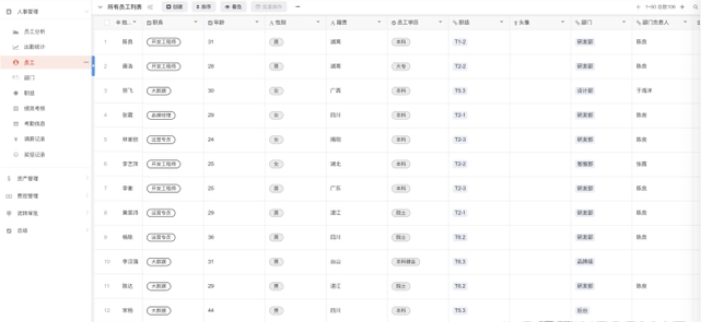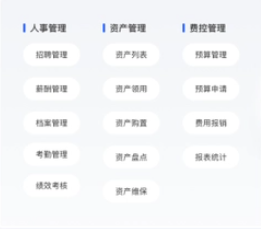What does OA mean?
OA, which stands for Office Automation, is a term that refers to the integration of modern office practices with computer technology. In a nutshell, OA represents a new way of working in offices. Any use of various new technologies, machines, and devices for office tasks in a traditional office falls within the realm of office automation. OA systems are designed to meet the goal of achieving more efficient organizational objectives. With the development of computer technology and the advancement of corporate organizations in modern civilization, OA systems software has emerged.
If this explanation is still unclear, let me provide another example to help you understand. In the past, when people talked about OA, they simply referred to office automation, but the meaning of office automation is too broad. Essentially, you can think of OA as the perfect collaboration among different departments, branches, and subsidiaries within a company to accomplish specific tasks. Before most companies embraced information technology, collaboration on tasks was often done through tools like QQ, MSN, or other remote communication methods. However, these tools lacked the ability for leaders to oversee the entire process of an event, were not conducive to control and approval processes, and had the potential for information leaks. The role of OA is to facilitate seamless collaboration among various departments, subsidiaries, and branches and enable leaders to observe their work processes. It allows for approval, control, and helps prevent work failures.

The Past and Present of OA (Office Automation)
-
First Stage: Document-Oriented OA (1980s) In the initial phase of OA development, dating back to the 1980s, China's understanding of OA began to take shape. The first National Office Automation (OA) Planning Conference was convened in 1985. At that time, computers were a rarity, and the early OA implementation started with standalone office application software such as WPS and MS OFFICE. Many referred to OA as "paperless office" during this period. This phase primarily focused on individual work behaviors, emphasizing services like document digitization, earning it the title "Document-Oriented OA." IBM's Lotus Domino, launched in 1989, was a groundbreaking product, excelling in email, collaboration, non-structured document processing, and security mechanisms. Domino's technology dominated the OA software landscape, capturing over 90% of the market share among large state-owned enterprises and institutions. Its advantages included exceptional system stability and robust underlying architecture, catering mainly to large enterprises and institutions. However, drawbacks included poor system openness, making data integration with other management systems challenging. The technology was complex, requiring specialized personnel for implementation, maintenance, and secondary development, resulting in high costs.
-
Second Stage: Process-Oriented OA (2000–2005) In the second stage, characterized by diversification, the market witnessed a multitude of developments. With the evolution of Java technology and increased awareness of the importance of software openness, scalability, and compatibility, Java quickly became the primary tool for enterprise-level management software development. Many domestic enterprises began adopting Java OA systems, leading to a proliferation of collaborative office system products. This period transitioned from individual-focused, document-centric OA with a core focus on office file/archive management to the prevalent Process-Oriented OA. This phase, centered around workflow, facilitated practical functionalities like document circulation, process approvals, document management, policy management, meeting management, vehicle management, and news dissemination. It marked the true rise of the OA market, with several professional OA software companies emerging to meet the robust market demand. However, the market was still immature, experiencing a prolonged period of mixed offerings and intense competition. Only a few OA manufacturers, emphasizing post-implementation services and continuous product upgrades, stood out.
-
Third Stage: Knowledge-Oriented OA (2005–2010) As OA system applications deepened, employees in enterprises found themselves logging into OA systems as the first task of their workday. OA became an indispensable platform for daily work, giving rise to new challenges. How could this platform facilitate employees' rapid access to diverse knowledge in different scenarios? How could it help organizations crystallize best practices and disseminate them throughout the entire organization? In response to these demands, a new era of OA development emerged, known as "Knowledge-Oriented OA." Rooted in the principles of knowledge management, collaborative work, and portal technology, this OA system integrated information and resources within organizations. As a result of technological advancements and user preferences, the older generation leader (Lotus Domino) gradually exited the market, and new giants divided the domestic market, shaping the current landscape.
-
Fourth Stage: Platform-Oriented OA (2010–Present) The most advanced OA collaborative office systems, currently in use, truly realize enterprise-level, platform-based applications. They run parallel to business management systems, not directly participating in specific business process management but possessing advanced management functions. This period has seen the emergence of "low-code" construction of OA systems, allowing enterprises to easily and rapidly configure OA systems using low-code platforms. This enables agile responses to their business processes without the need for extensive code writing. The visual and graphical components significantly enhance the flexibility, operability, and modifiability of OA systems.
Three, Core Functions of OA
Commonly seen in the market, OA software possesses various core functions, including but not limited to:
- Workflow Approval: Streamlining the approval processes.
- Collaborative Work: Facilitating teamwork and cooperation.
- Document Management (for state-owned enterprises and government agencies): Managing official documents.
- Communication Tools: Enhancing communication within the organization.
- Document Management: Efficiently managing documents.
- Information Center: Serving as a centralized hub for information.
- Plan Management: Managing plans and schedules.
- Project Management: Overseeing project-related activities.
- Task Management: Organizing and tracking tasks.
- Meeting Management: Coordinating and managing meetings.
- Associated Personnel: Managing relationships and connections between individuals.
- System Integration: Integrating with other systems.
- Portal Customization: Customizing portal interfaces.
- Address Book: Maintaining an organizational directory.
- Work Notes: Keeping track of work-related notes.
- Survey Questionnaires: Conducting surveys.
- Common Tools (Calculator, Calendar, etc.): Providing various utility tools.
In specific domains, the OA platform adopts an architecture model based on frameworks, application components, and customized functionalities. It comprises more than 30 subsystems, including information portals, collaborative work, workflow processes, form centers, document circulation, public information, forum management, survey management, plan management, conference management, task management, associated projects, associated personnel, document management, external emails, online exams, vehicle management, item management, equipment management, common tools, transaction centers, online messages, supervisory systems, SMS platforms, human resources management, customized functionality platforms, integrated platforms, system management, and nearly ten thousand functional points.
Despite the increasing functionalities in OA software, more does not necessarily mean better. Some enterprises prefer customized software to avoid unnecessary features that may waste resources and time. Customization allows for flexibility, focusing only on the most used features to maximize efficiency. In today's market, OA systems constructed using low-code methods align well with the customization needs of many enterprises.
So, what is low code? In simpler terms, low code is a set of digital technology tools and platforms that efficiently enable rapid construction, data orchestration, ecosystem connectivity, and middle-tier services through graphical drag-and-drop and parameterized configurations. It achieves innovative scenario applications in digital transformation with minimal or no coding. Low code addresses the challenges arising from the contradictory issues between the massive market demand and the productivity issues caused by traditional development. It is a product of the trend towards reducing costs and increasing efficiency in the digital transformation process.







